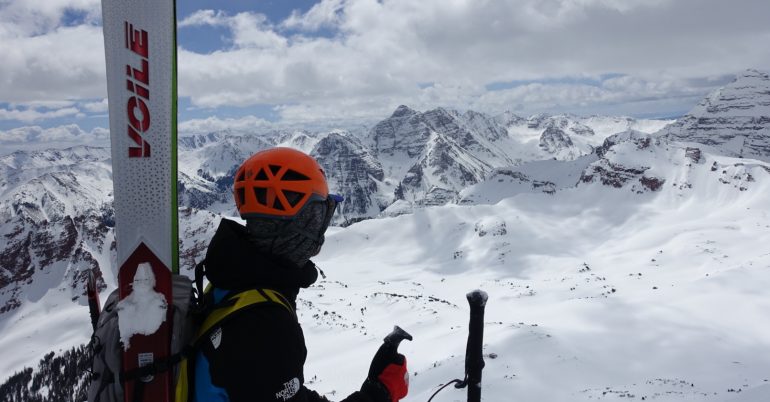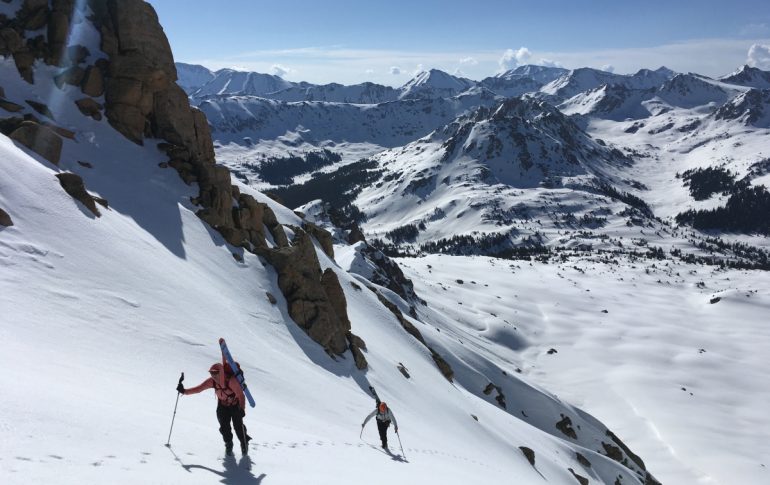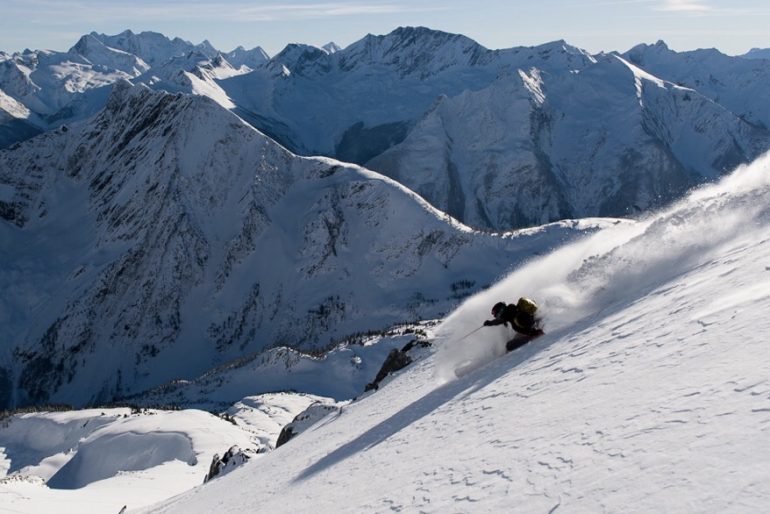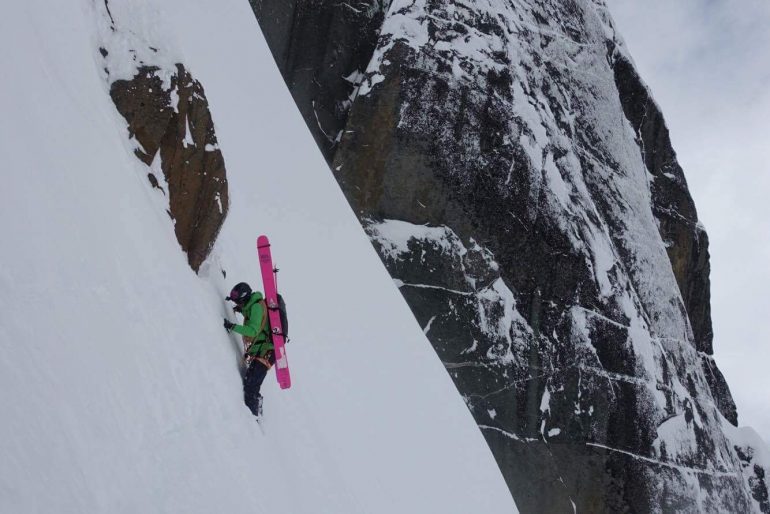Globe trotting pro skiers weigh in on the home range
The allure of unknown terrain has long been sought in backcountry skiing. Big budget festival films glorify the novelty of unskied lines on the edges of exploration. In ski towns around the world, even the most dedicated locals embark on the increasingly popular “Japanuary” migration. Just this spring, I joined many others flocking to Northwest to harvest spring volcano snow despite that Colorado was having its deepest May in recent history.
While it’s tempting to look to far off lands with rose colored goggles, maybe the best skiing adventures can be found within driving distance. For many sponsored skiers with enviable budgets to ski around the world, those edges and those wild lines are most gratifying when they stay put.
Take North Face athlete Christina “Lusti” Lustenberger who we had on the Totally Deep Backcountry Skiing Podcast last week. I had a chance to follow up with her while she was visiting Aspen for a late May training trip. After sipping spritzers and hearing her take on the merits of skiing in her home mountains, I was ready vow to never leave the Colorado Rockies again.
Of her home hills where she tests her mettle she says, “It’s really nice being in a place where there is a lifetime of exploring and ski touring and a place that is going to allow you to grow as an athlete or a person of the mountains.”
She’s referring to the whimsical glaciated peaks and valleys of interior British Columbia where Christina was born and raised on skis. Her father owned a ski shop at the base of Panorama resort in Invermere B.C., and by age six Christina was training to race. Several World Cup tours, a showing at the 2006 Winter Olympics and five corresponding knee surgeries later, she retired.
Since then she’s been quietly sneaking into the public consciousness of big mountain ski mountaineering. Recently, she was featured in the Sherpas film Children of the Columbia, in which she Christina drops a gut flipping line on Wildcat Peak in British Columbia. It’s one of many big mountain lines she ruminated on before even thinking of attempting.
“Most of the lines I see as a possible first descent, I see many years before going and trying. They are in the back of my mind as wonders. Wondering what it would take and who would be a good partner.”
Her next objective, for example, is one she’s been eyeing for much of her life.
“It’s a line that I grew up looking at as a child,” she says. “At some point in my teenage years I all of the sudden looked at it with a little more curiosity in the sense of wondering if it could be skied.”
So now, each winter, she waits and she watches the snow fill it in. Patience, she says, is key.
“I wait for my confidence and motivation to be high, wait for conditions to confirm a good success and then convince myself it’s time to try it. Sometimes it’s the first, second, or third try…” And sometimes, being deeply familiar with the snowpack and conditions is enough to give her the go-ahead.
Such was the case with her first descent of Black Friar Couloir, a sheer line in the Adamant Mountains in BC with a 60 degree ice pitch that Christina opted to ski through rather than rappel.
“Black Friar is a good example of having a specific line in the back of my head, thinking about it for many years and finally, after waiting for the right conditions, right partners and weather, things aligned and we were successful… Knowing what kind of snow season we had, it made perfect sense to take the risk and fly in to give the line an honest go.”
Christina still travels for skiing more than most of us do in a lifetime. Her trip to Aspen was a stand-in for a North Face team Russia ski expedition that had been cancelled. Despite the constant opportunity to ski essentially wherever she dreams, she says the bottom line is that staying local just can’t be beat.
“When you travel across the world you have to rely on other people which can be a really great asset to have local beta.” But, she says “being at home definitely gives you that strength and encouragement and the local knowledge that carries your confidence into the mountains.”
An additional take from guide Nate Rowland
Ok, ok. Maybe not all of us can live in a proving ground so plentiful as Interior BC, but we can still make a point to be as educated about and familiar with the snowpack we ski most often. To get some additional perspective, I checked in with Aspen local, ski guide and fellow North Face athlete Nate Rowland. For Nate, who spends the majority of his ski days in the Aspen area, the merits of digging deep into nearby peaks are multifaceted.

A lifetime of objectives presents itself from a high summit deep in the Maroon-Snowmass Wilderness. Photo: Tyler Christoff
“If you’re skiing your home range, you can always match your objective to the conditions, whether you’re skiing it because it’s soft or you’re skiing it because it’s safe,” he says. “You’re making decisions based more on that instead of skiing it just because it’s there, or you’re there, which is something that happens a lot when you’re on objective based expeditions.”
“It always circles back to the safety stuff for me,” he continues. “From a guiding perspective and a skiing for fun perspective. If you know the history of the snowpack because you’ve lived it, it can help you anticipate trouble spots.” And when you do dig pits, you can verify what you already know. “So instead of saying ‘oh that’s a troublesome layer,’ you’re saying ‘oh that’s December 15.'”

“We could ski that, and that, and that…” Skiing on Colorado’s Independence Pass went well into late June this year. Photo: Nathan Rowland
But also, he says, it’s just fun to really get to know an area. “You can get to the summit and look around and say ‘I want to ski that, and that, and that.’ And if you’re in your home range, that’s just what you do. Your next day is informed by what you saw the day before.”
And the view from ski legend Greg Hill
Just for one more take, I connected with another formerly-wide ranging skier, Greg Hill, who in recent years is all about that electric car. He lets the car’s range designate his local turf, and says that as long as he’s not on a sponsored trip, 100% of his personal adventures are in the BC, Alberta and Montana zone. Beyond being more environmentally friendly, he also appreciates the sentimentality of staying close to home.
“There’s so much more value to your backyard adventures because you see them more often when you climb your next mountain,” he said over a quick phone chat. “You look over and there’s just more to the adventures because they keep reliving themselves.”
So: skiing in optimal and safe conditions? Check. Cultivating the base knowledge to push your limits? Check. Inspiring the fuzzy warm feelings of nostalgia? Check.
Being able to admire your figure eights as you sip beers at the car after? Ok, you can pretty much do it whether you flew in or not, but all this talk of staying local got me thinking about staying closer once the snow starts flying again. And next time I see ‘gram posts of somebody’s great Japanuary powderfest, maybe instead of swooning I’ll pick an objective in the peaks nearby and wait ever so patiently for the right day to give it a try.
Thoughts, readers? What are your favorite things about skiing close to home?
Manasseh Franklin is a writer, editor and big fan of walking uphill. She has an MFA in creative nonfiction and environment and natural resources from the University of Wyoming and especially enjoys writing about glaciers. Find her other work in Alpinist, Adventure Journal, Rock and Ice, Aspen Sojourner, AFAR, Trail Runner and Western Confluence.



